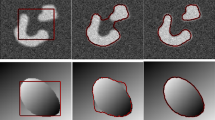Abstract
Snake-based methods are commonly used to segment ultrasound images. However, their performance is generally limited because of the specific properties of this kind of images. This paper addresses the sensitivity of parametric active contours to speckle within ultrasound images. We propose a new B-spline snake model, founded on two original external energies specifically tailored for the segmentation of biomedical speckled images. First, the curve is attracted from a wide capture range with an expansion energy that facilitates the snake initialization. Then, it is accurately fitted on the region boundaries with an energy that allows precise positioning of the curve along edges in ultrasound images. A mutual inhibition function is designed to control the two energies. Results on real ultrasound images are presented and quantitatively compared to the boundaries manually outlined by experts. Our method improves the precision of heart cavities segmentation.









Similar content being viewed by others
References
Borgefors, G. (1988). Hierarchical chamfer matching: A parametric edge matching algorithm. IEEE Transactions on Pattern Analysis And Machine Intelligence, 10, 849–865.
Brigger, P., Hoeg, J., & Unser, M. (2000). B-spline snakes: A flexible tool for parametric contour detection. IEEE Transactions on Image Processing, 9, 1484–1496.
Caselles, V., Kimmel, R., & Sapiro, G. (1997). Geodesic active contours. International Journal of Computer Vision, 22, 61–79.
Chan, T., & Vese, L. (2001). Active contours without edges. IEEE Transactions on Image Processing, 10(2), 266–277.
Cohen, L. (1991). On active contour models and balloons. Computer Vision, Graphics, And Image Processing: Image Understanding, 53, 211–218.
Davatzikos, C., & Prince, J. L. (1995). An active contour model for mapping the cortex. IEEE Transactions on Medical Imaging, 14, 65–80.
Delingette, H., Hebert, M., & Ikeuchi, K. (1991). Shape representation and image segmentation using deformable surfaces. Image and Vision Computing, 10(3), 132–144.
Dubuisson, M. P., & Jain, A. K. (1994). A modified hausdorff distance for object matching. In International conference on pattern recognition. Jerusalem, Israel, October.
Farin, G. (1992). Curves and surfaces for computer-aided geometric design. London: Academic.
Foley, T. (1987). Interpolation with interval and point tension controls using cubic weighted ν-spline. ACM Transactions on Mathematical Software, 13, 68–96.
Jacob, M., Blu, T., & Unser, M. (2004). Efficient energies and algorithms for parametric snakes. IEEE Transactions on Image Processing, 13, 1231–1244.
Jehan-Besson, S., Barlaud, M., & Aubert, G. (2003). DREAM2S: Deformable regions driven by eulerian accurate minimization method for image and video segmentation. International Journal of Computer Vision, 53, 45–70.
Kass, M., Witkin, A., & Terzopoulos, D. (1988). Snakes: Active contour models. International Journal of Computer Vision, 1, 321–332.
Leventon, M. E., Grimson, W. E. L., & Faugeras, O. (2000). Statistical shape influence in geodesic active contours. Computer Vision and Pattern Recognition, 1, 316–323.
Lopes, A., Touzi, R., Nezry, E. (1990). Adaptive speckle filters and scene heterogeneity. IEEE Transactions on Geoscience and Remote Sensing, 28, 992–1000.
Lopes, A., Nezry, E., Touzi, R., & Laur, H. (1993). Structure detection and statiscal adaptive speckle filtering in SAR images. International Journal of Remote Sensing, 14, 1735–1758.
Malladi, R., Sethian, J. A., & Vemuri, B. C. (1995). Shape modeling with front propagation: A level set approach. IEEE Transactions on Pattern Analysis and Machine Intelligence, 17, 158–174.
Neuenschwander, W., Fua, P., Szekely, G., & Kubler, O. (1994). Making snakes converge from minimal initialization. Conference ARPA Image Understanding Workshop, 2, 1627–1636.
Park, H., Schoepflin, T., & Kim, Y. (2001). Active contour model with gradient directional information: Directional snake. IEEE Transactions on Circuits and Systems for Video Technology, 11, 252–256.
Pluempitiwiriyawej, C., Moura, J., Wu, Y., & Ho, C. (2004).STACS: New active contour scheme for cardiac MR image segmentation. IEEE Transactions on Medical Imaging, 24(5), 593–603.
Precioso, F., Barlaud, M., Blu, T., & Unser, M. (2003). Smoothing b-spline active contour for fast and robust image and video segmentation. Image Processing, 2003. Proceedings. 2003 International Conference on (Vol. 1, pp. 37–40).
Ronfard, R. (1996). Region-based strategies for active contour models. International Journal of Computer Vision, 13, 229–251.
Tauber, C., Batatia, H., & Ayache, A. (2004). A robust speckle reducing anisotropic diffusion. Proceedings of IEEE international conference on image processing ICIP.
Unser, M. (1999). Splines: A perfect fit for signal and image processing. IEEE Signal Processing Magazine, 16, 22–38.
Xu, C., Prince, J. L. (1998). Snakes, shapes, and gradient vector flow. IEEE Transactions on Image Processing, 7, 359–369.
Author information
Authors and Affiliations
Corresponding author
Rights and permissions
About this article
Cite this article
Tauber, C., Batatia, H. & Ayache, A. Robust B-spline Snakes For Ultrasound Image Segmentation. J Sign Process Syst Sign Image Video Technol 54, 159–169 (2009). https://doi.org/10.1007/s11265-008-0186-6
Received:
Revised:
Accepted:
Published:
Issue Date:
DOI: https://doi.org/10.1007/s11265-008-0186-6




